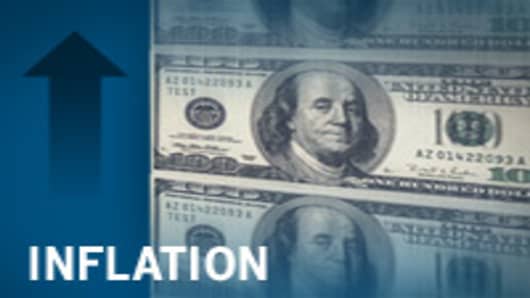There's more than just a whiff of inflation in the air, especially if you're standing outside a Hershey chocolate factory or shopping in a Walmart.
Hershey announced earlier this week a nearly 10 percent price increase across its line of candy products to cover rising raw material costs, fuel and transportation.
Those rising costs are affecting many other manufacturers that rely on everything from diesel fuel to corn to cotton to copper and of course, cocoa.
It will also be true if you are shopping in Walmart, or anywhere else.
Wal-Mart Stores CEO Bill Simon said this week that inflation "is going to be serious" and price rises are already showing up in dairy and cotton products and more are coming in transportation-related products.
The topic of inflation also is taking on greater prominence among members of the Federal Reserve—and thus investors. Several of the more hawkish Fed members in recent days have stepped up their calls for the central bank to end its stimulus program in June and begin thinking about raising interest rates.
Richmond Fed President Jeffrey Lacker, for instance, told CNBC Friday that he "wouldn't be surprised" if the central bank raised interest rates by the end of the year.
The day before, Minneapolis Fed President Narayana Kocherlakota told the Wall Street Journal that benchmark borrowing costs, which are now close to zero, could rise by three-quarters of a percentage point by the end of the year.
Still, while Friday's stronger than expected jobs report showed the economy is doing better, it unclear whether the Fed is ready to change its ultra-easy monetary policies.
New York Fed President William Dudley, for instance, said Friday that the central bank shouldn't reverse course despite the improving jobs picture.
"We are still very far away from achieving our dual mandate of maximum sustainable employment and price stability," Dudley said in a speech. "Faster progress towards these objectives would be very welcome."
The debate over inflation is not just within the Fed. Many economists also are divided over the threat.
Moody's Economy.com economist Mark Zandi said the idea that inflation is picking up may be actually more of a reality than economists are currently forecasting. He said he attended a meeting with consumer products companies officials this week, and he heard plenty.
"They were all on the verge of jacking up their prices," he said. Price increases are not always seen as bad though. When companies have pricing power, it often means there is some traction in the economy, but it's a fine balance.
The threat of inflation is even more worrisome now that oil has crossed above $105 per barrel and looks set to stay high due to unrest in the Middle East. Some commodities have also seen shortages for other reasons and that has combined to drive prices. For instance, cocoa, trading lower Thursday, has been driven higher by civil war in Ivory Coast.
"You would expect some kind of pass through, with the surge in commodities prices. It's not unusual, at least not yet. The key is if this becomes self-reinforcing and drives inflation expectations and wage demands," Zandi said.
Zandi currently expects overall CPI inflation to accelerate from 1.7 percent in 2010 to 2.4 percent in 2011, and then moderate in 2012 to 2.1 percent as oil and food prices stabilize. He sees core inflation, without food and energy, at 1.4 percent in 2011 and 2.1 percent in 2012, from less than 1 percent in 2010.
The markets have been watching this creeping trend of higher prices, which has been much more dramatic outside the U.S. but is now increasingly showing up inside the U.S.
The Fed's easy monetary policy has been blamed in part for the weakening dollar and run-up in commodities prices around the globe.
Kansas City Fed President Thomas Hoenig is one of the Fed presidents who has been outspoken about the Fed's low rate and easy money policies and he was vocal again this week.
"While some of the increase may reflect global supply and demand conditions, at least some of the increase is driven by highly accommodative monetary polices in the United States and other economies," said Hoenig.
All this public debate by Fed members about inflation may be intended, says Zandi.
"I think they were trying to prepare us for moving from stimulus to restraint," he says. "There's a fair amount of debate as to the timing and how aggressively they should tighten. I think it's appropriate for them to start this discussion now."
Questions? Comments? Email us at marketinsider@cnbc.com



